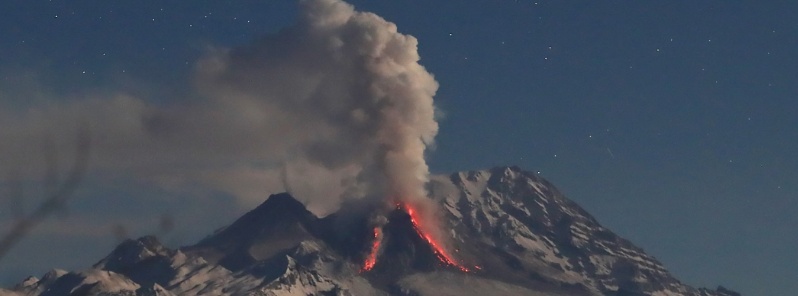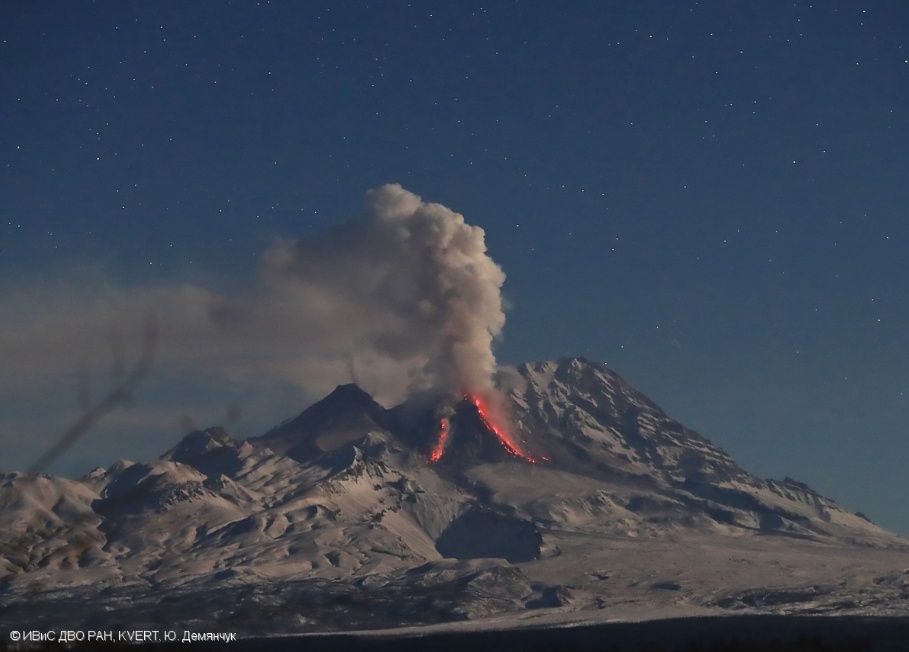Strong eruption at Sheveluch volcano, Aviation Color Code Red, Russia

A strong explosive eruption took place at Sheveluch volcano, Kamchatka, Russia at 05:49 UTC on March 9, 2019. The Aviation Color Code was raised to Red.
The eruption ejected volcanic ash up to 10 km (33 000 feet) above sea level, drifting NW. This is 6.7 km (21 980 feet) above the crater rim.
Satellite data by KVERT showed the ash cloud at the height of 8 km (26 200 feet) a.s.l. continues to drift about 375 km (233 miles) to the north of the volcano, KVERT said 13:12 UTC.
A moderate gas-steam activity volcano continues at the volcano, the observatory said, adding that ash explosions up to 10 – 15 km (32 800 – 49 200 feet) a.s.l. could occur at any time. Ongoing activity could affect international and low-flying aircraft.

Growth of the lava dome continues (viscous lava blocks extrude out on the northern part of it), a strong fumarolic activity and incandescence of the dome blocks and hot avalanches accompanies this process. Credit: Yu. Demyanchuk. IVS FEB RAS, KVERT
KVERT reported that a thermal anomaly over Sheveluch’s lava dome was identified daily in satellite images during from February 22 to March 1. Strong gas-and-steam emissions contained variable amounts of ash on February 21, 25, and 27, and rose 4 – 5 km (13 100 – 16 400 feet) a.s.l. and drifted 100 km (62 miles) SW and E.
Sheveluch’s lava dome continued to grow, extruding blocks on the N side, and producing hot avalanches and fumarolic plumes during February and into March.
Geological summary
The high, isolated massif of Sheveluch volcano (also spelled Shiveluch) rises above the lowlands NNE of the Kliuchevskaya volcano group. The 1 300 km3 (311.9 mi3) volcano is one of Kamchatka's largest and most active volcanic structures. The summit of roughly 65 000-year-old Stary Shiveluch is truncated by a broad 9-km-wide (5.6 miles) late-Pleistocene caldera breached to the south. Many lava domes dot its outer flanks. The Molodoy Shiveluch lava-dome complex was constructed during the Holocene within the large horseshoe-shaped caldera; Holocene lava dome extrusion also took place on the flanks of Stary Shiveluch.
At least 60 large eruptions have occurred during the Holocene, making it the most vigorous andesitic volcano of the Kuril-Kamchatka arc. Widespread tephra layers from these eruptions have provided valuable time markers for dating volcanic events in Kamchatka. Frequent collapses of dome complexes, most recently in 1964, have produced debris avalanches whose deposits cover much of the floor of the breached caldera. (GVP)
Featured image credit: Yu. Demyanchuk. IVS FEB RAS, KVERT

this is great an goes with BIBLE. I will support on next check. Im on S.S. GOD bless.